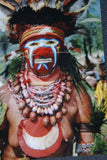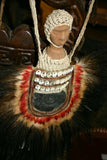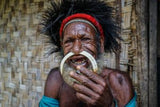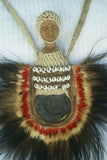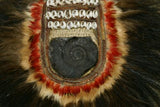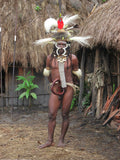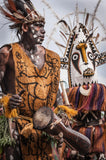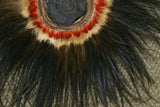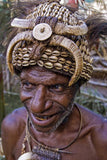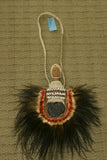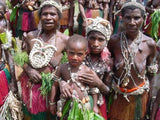Rare Body Art : Dani Big Man Pectoral Trophy, Bride Price, Currency, Feud Payment Collectible: Ammonite, Cassowary, Seed beads, Bark Twine, Hand Carved Ancestor Face etc… late 1900’s. Museum Quality, Baliem Valley, Irian Jaya, New Guinea.
HIGHLY COLLECTIBLE
Rare South Pacific Art.
Amazing Unique Dani Big Man Status Symbol, Trophy Pectoral adornment, worn during Initiations, Rites of Passage, Ceremonial Events, Funerals.
From Irian Jaya, West New Guinea
Item number AMM1.
This very rare authentic amazing Dani, warrior or chief, Status symbol, a pectoral decoration, worn hanging from the front or the back of the tribal’s man upper body, was a pride to its owner and a wealth object as well, often used as local currency, worth, bride price, as payment during feuds, or as a valuable trade item, in the Baliem Valley of West New Guinea.
It can be worn or used as a unique decoration in one's home.
Measures: 25"X15"X15"
The pectoral decoration or necklace consists of an ancient Ammonite surrounded by Parrot, Lory, cassowary feathers, nassa shells, hand twisted bark twine, hand carved wood carving, in the shape of an ancestor head and meant to protect the owner, a village chief, from evil lurking in the surrounding jungle.
This chest pectoral ornament was collected in the field, Baliem Valley.
Such scarce South pacific art creations were highly valued by Dani warriors, chiefs and clans: they wore such pectoral decorations with pride during special ceremonies, funerals, weddings, rites of passage, initiations, sing-sings etc… and it was a wealth object as well, worn by men of courage, status, and rank.
I saw one once on the internet selling by itself for 950.00 dollars. Never saw another one since.
The tribes or Irian Jaya, Indonesia and Papua New Guinea have lived in isolation for centuries due to the remoteness of their land and its difficult access. Their dress code has remained primitive for centuries. Traditionally, the men wear no other clothing apart from a penis sheath made of a cultivated gourd and known locally as a “horim” and some simple ornamentation such as string hair nets, bird of paradise feathers and necklaces with boar tusks or cowrie shells or other. On ceremonial days, it is another matter, they then use material from the surrounding jungles to create incredibly colorful and clever body adornments and costumes, as seen on the photos here as well.
Shell, teeth, bone, wood, beads and natural fiber binding, all crafted with great care, are the raw materials of most Oceanic jewelry. Brightness and shininess were greatly admired, and rarity, as with whale teeth among Polynesians or shell in the highlands of PNG, enabled particular objects to connote wealth, prestige, and power.
Adornment among the highland people is among the most colorful and spectacular in Papua New Guinea, particularly during festivals, where it reflects the strength and pride of the various groups of the region.
Artistic expression, there, is conveyed largely through body art. Diverse in both media and application, the major components of Highlands body ornamentation as we mentioned above include bird of paradise plumes, body paint, and an enormous variety of decorative objects made from shell, teeth, beetles, orchid stem, fur, bone, bark, wood, and fiber. Moriarty recognized the importance of this art and its central position in the broader context of art. A visionary in any age, he not only developed a unique collection of body decoration from the Highlands of New Guinea collected between 1850 and 1880, but saw to it that this collection remained intact by donating it to the AGNSW. Today it is part of what is possibly the world's most important accumulation of this art.
We carry many other artifacts we collect direct from the tribes, in East and West Papua and the Trobriands and remote islands of Indonesia
All our collector and rare items come with pages and pages of research about provenance, and with history of the tribes and photos as well, depending on item and whenever possible. When shipping internationally, we group ship multiple purchases to save you money, and find the best rates available. If you have any questions or want to see research conducted on this piece and photos of tribes, let us know.
































